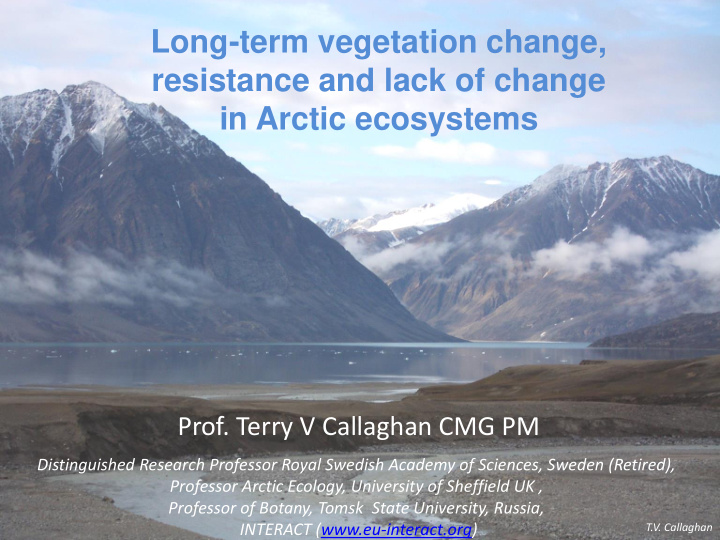



Long-term vegetation change, resistance and lack of change in Arctic ecosystems Prof. Terry V Callaghan CMG PM Distinguished Research Professor Royal Swedish Academy of Sciences, Sweden (Retired), Professor Arctic Ecology, University of Sheffield UK , Professor of Botany, Tomsk State University, Russia, INTERACT (www.eu-interact.org) T.V. Callaghan
Back to Basics – IPCC 1990 “Ecosystems ….may not be able to keep pace with climate change.” (Little mention of events) Literature search based on Potential range increases versus decreases for 2 x CO2 ( Gatti et al., in prep .): Realised range Prelim. Of 356 Arctic papers, 100 years: 89.7% greening 10.3% browning Greening? ?% No change Current range From satellite-based NDVI Browning? (1982-2012) ( Xu et al., 2013 ): 32-39% greening No change? 4% browning 61-68% no significant change Present and future range of eastern hemlock (Hansen et al., 1983, Melillo et al., 1990 in IPCC)
No change? 1967 2010 Xu et al., 2013
Over-looked long time scales Pre-adaptation to weather extremes? Sub-arctic Lycopodium annotinum clones can survive over 1000 years Siberian Carex species clones can survive over 3000 years
UV-B effects on plants are few as they have experienced higher UV-B in the Holocene Helsinki Abisko ( Phoenix et al.; Hultén )
Current species distributions can tell us about the future: = geographical analogues 2080 2050 2020 2000 Growth of plants in warmer parts of their present ranges is an analogue of growth under future warmer climates at their northern distributions: plants at the extreme southern limit may not be able to grow more and will be replaced Cassiope tetragona
Over-looked wide geographical ranges Eriophorum and thermokarst thaw slumps – Sub- arctic Sweden Eriophorum and peat slumps – ……………………………… Manchester UK!!!!
Disko Island, mid-west Greenland • Obvious landscape Primarysite change, • little vegetation change • little species change • Pond size • little growth change . • Salix shrubs denser on slope • Salix shrubs increase on valley floor • Warm spring creek
Primary Site Community structure 40 50 Percentage frequency change disappearance increase appearance Percentage cover cahnge appearance decrease disappearance increase decrease 20 25 0 0 -20 -25 -40 -50 Percentage frequency change Percentage cover change Callaghan et al., 2011
Species response Lack of ability to respond opportunistically – limit of structure Phleum alpinum biotic limit Phleum alpinum environmental limit Callaghan et al., 2011
Lack of ability to respond opportunistically - deterministic form (sensitive to invasion)
Disko Island Fell-field site: No substantive change in landscape or species. 1967 8 mm cine film frames and 2009 digital photo.
Fell field Site 80 Percentage frequency change 40 disappearance appearence appearance 60 Percentage cover change increase decrase decrease disappearance increase 40 15 20 0 -20 -10 -40 -60 -35 Percentage frequency change Percentage cover change Callaghan et al., 2011
Ultimate stability? Svalbard Proportion of the mapping 1936 2008 units in 1936 and 2008 in Acock This percentage of the total (1940) study area of the lower part of the mapped strip (1) Low cover of Dryas octopetala 28.6 28.6 (2) Dryas octopetala with Carex 25.4 26.5 misandra (3) Dryas octopetala with Carex 18.9 20.2 rupestris (4) Moss vegetation with Carex 13.0 11.9 subspathacea, including Eriophorum scheuchzerii swamps (5) Stream marginal vegetation 1.5 3.0 usually with Dupontia psilosantha (6) No vegetation 1.8 0 (7) Permanent water bodies 10.8 9.8
Rapid landscape change – little vegetation change Tareya, Taimyr Dickson 1967 1967-2010 1980-2012 General greening in Of the 117 newly-formed species recorded depressions due to a in 2012, 24 lower accumulation of species had slight 2010 dead matter rather differences in than to any changes in pattern within N.Matveyeeva composition or species the landscape 2010 abundance. 162 species of the 93 were former 213 had the distributed as same local distribution earlier. and abundance as earlier 1994- 2050? Ultimate browning?. 2003
Warmth-loving aspen ( Populus tremuloides ) in birch Counter-intuitive responses forest ( Betula pubescens ) has not responded to recent warming – why? Aspen stand, September 9, 1978. 1937 Photo: Abisko Station. 1959 Aspen stand, September 9, 2008 . Abisko treeline Photo: Abisko Station. Photo: Sandberg, 1963 Shrubification during cooling Homeostasis during warming Van Bogaert et al., submitted
Case study 4 : shrub expansion in But first step is to correlate with climate the tundra (Sturm et al., Nature 2002) – why? (Olofsson et al., 2009) Alaska 1950 Experiments might help Sturm, 2002 to understand causes Tape, 2002
Pathology of change A A 3 4 1977, Swedish Lapland 2009, 600% increase in cover + new tree species Pre-1939
Land use changes reinforce climate impacts Pålnoviken North of Pålnoviken 1906 1986
(Olofsson et al., 2009) Pathology – role of animals Control Reindeer exclosure Vole exclosure
The outcome of the tree competition is determined by moose and caterpillars which are themselves impacted by climate change (below is birch forest damage in 2004. Such events allow aspen to colonise)
Multiple changes can be seen in one area experiencing the same climate changes up down And stays Van stable Bogaert et al., 2011 Van Bogaert et al., in press, J Biogeography
Confusing effects of time scale: cycles? We don’t live long enough! “ khasyrei “ cycles 10’s to 100’s of years: greening then browning thermokarst drainage Palsa formation S. Kirpotin
Biology is driven by events: we are poor at observing these Births Deaths Relocation Mutation/evolution Extinction Duration and magnitude of events is a human perspective
Re-visiting greening in 2016 N.A.Anderson 1977, Swedish Lapland S. Rundqvist Recent vegetation browning: Epstein et al, 2016 Xu et al., 2013
INTERACT Trans-national access: ca. 600 researchers given access 2010-2017 ( www.eu-interact.org ) Physical access - feet on the ground Remote access – tasks by station staff Virtual access - requests for data
Welcome to Salekhard, September 2018, “Building a large scale northern infrastructure” – contact Olga Morozova Thank you for your attention! SecNET
Recommend
More recommend